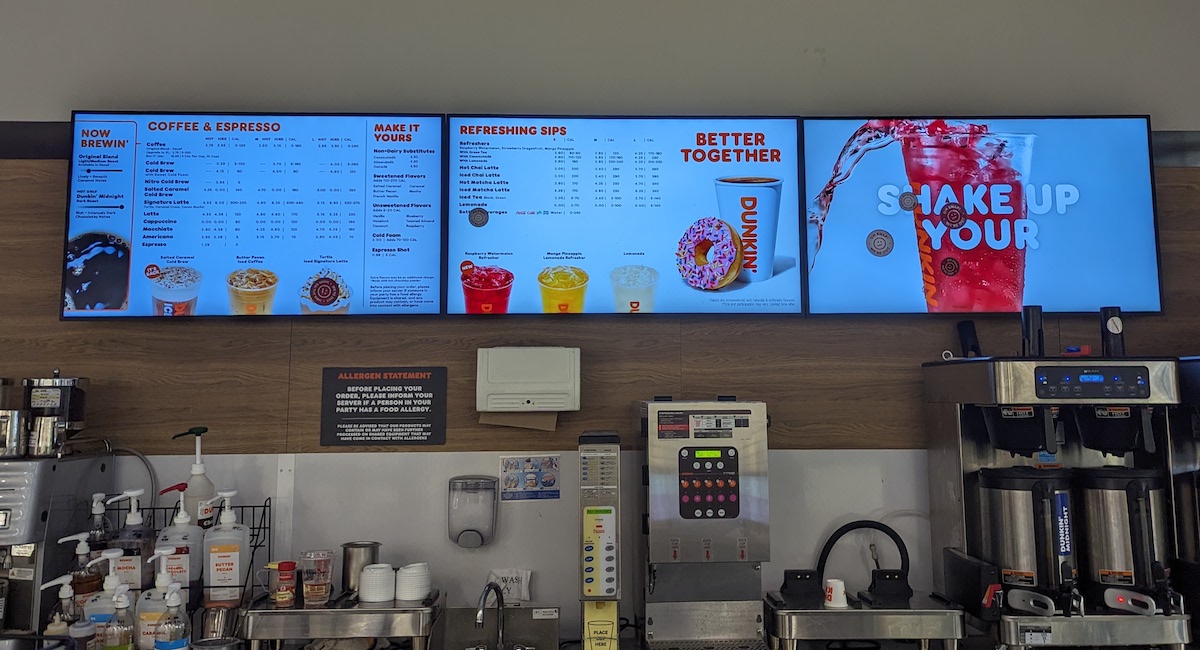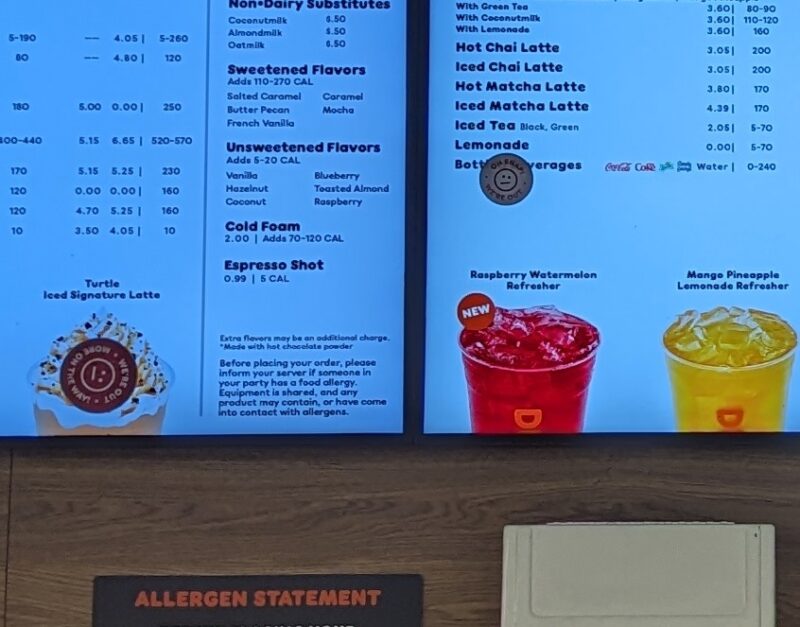
Store In QSR Giant Chain Uses Printed Labels To Hide Out Of Stock Items On Digital Menu Screens
July 11, 2023 by Dave Haynes
This is just sad – a major QSR chain using printed labels that staff evidently use to indicate out-of-stock menu items on the digital menu display boards behind the order counter.
We have all seen this sort of thing in places like food court malls – but the operators of those tend to be one-offs or part of very small, regional chains. This is in Dunkin’ Donuts, which has more than 13,000 locations globally. It was sent by an industry contact, and I don’t know the location.
It is undoubtedly hard to run businesses that large, and herd all the local store cats, making them use specific technologies and adhere to well-defined workflows. But someone in the decision chain decided to address a digital display problem with an analog solution, and bought stickers.
The particularly funny/sad part of this is the right hand display, which evidently cycles between menu listings and full screen promos, so the cluster of “Oh Snap We’re Out” labels looks particularly weird. The state of the art for menu displays is having data handshakes with a restaurant’s management systems, so that the menus are dynamic and just “disappear” items that aren’t available or in short supply.

Failing that, there is some sort of local control or updating available, even it is just a cloud-based spreadsheet the CMS can query.l
I have direct experience advising a big chain that didn’t trust local managers to use the CMS software (fearing screw-ups or all kinds or dumb notions or butt-ugly creative efforts), but software platforms tend to have workflows and approvals that resolve those sorts of issues. In this case, the store evidently just slaps up labels.
I am assuming this is not a head office-driven solution, and that the CMS used would support APIs and dynamic menus. You don’t win a job that big, I wouldn’t think, without some ability to deal with this sort of fundamental, baseline functionality.
I’m no electrical engineer, but I can’t imagine adhesive labels on a flat panel displays is all that wise.



This is indeed unfortunate and we see this type of behavior far more often than we should. As you mention, a dynamic solution that receives out of stock information from the POS is a really good solution for this (and honestly, should not at all be considered state of the art given how many ways up-to-date menus are being sent in APIs at this point – ahem, Doordash). Updated menus coming off APIs still requires a manual step from the folks in the restaurant to actually input that out of stock in the POS or other downstream system, but at least there is a clear reason for them to take that effort. Whenever you ask people at a local level to go into multiple systems to update the same information, you have already lost the battle. I think that is the part that is easy for us to forget – we have to think about multi-step mitigation for these cases to help ensure our clients see the best outcomes from implementing our solutions. For example, in addition to an integration to automate out of stock from product lists, we should also consider making product images (like the Turtle Iced Signature Latte) dynamic as well. We should understand and coach our clients on the workflows they expect, and the change management and training related to rollout at a local level. These atrocities in the field (stickers on a digital menu board – the horror!) end up being death by a thousand cuts when it comes to scaled rollout.
Having worked in fast-paced restaurants and now working with a team that manages digital content for thousands of restaurants, this story strikes a chord with me. Digital menu boards are attractive because they are easy to update and provide great-looking dynamic content that can be changed on the fly, increasing customer engagement. All of that is true. They are most effective when the brand has an excellent strategic plan for its digital content, clear objectives, and well-trained team members (from the corporate marketing and operations teams down to the local franchise owner and location manager). If not, breakdowns will inevitably happen. It all starts with the plan, which should include: 1. Who will be the primary content manager and the backup? Will this be an internal resource, or will it be outsourced? Who do we call for help when everyone on site is too busy to get things updated? 2. How far in advance can we set up the seasonal LTO schedule, and what do we do if things change? 3. How can we keep to a minimum the number of different internal and external parties that need to touch the content to be as efficient as possible? 4. What do we hope to improve by having digital menu boards (revenue, guest satisfaction, speed of service, etc)?
We have seen incredible success among our customers with digital menu boards, and we have also seen some that invest then don’t have the staffing or training to get the most out of them. Bottom line – the promise can be a reality with a good plan.